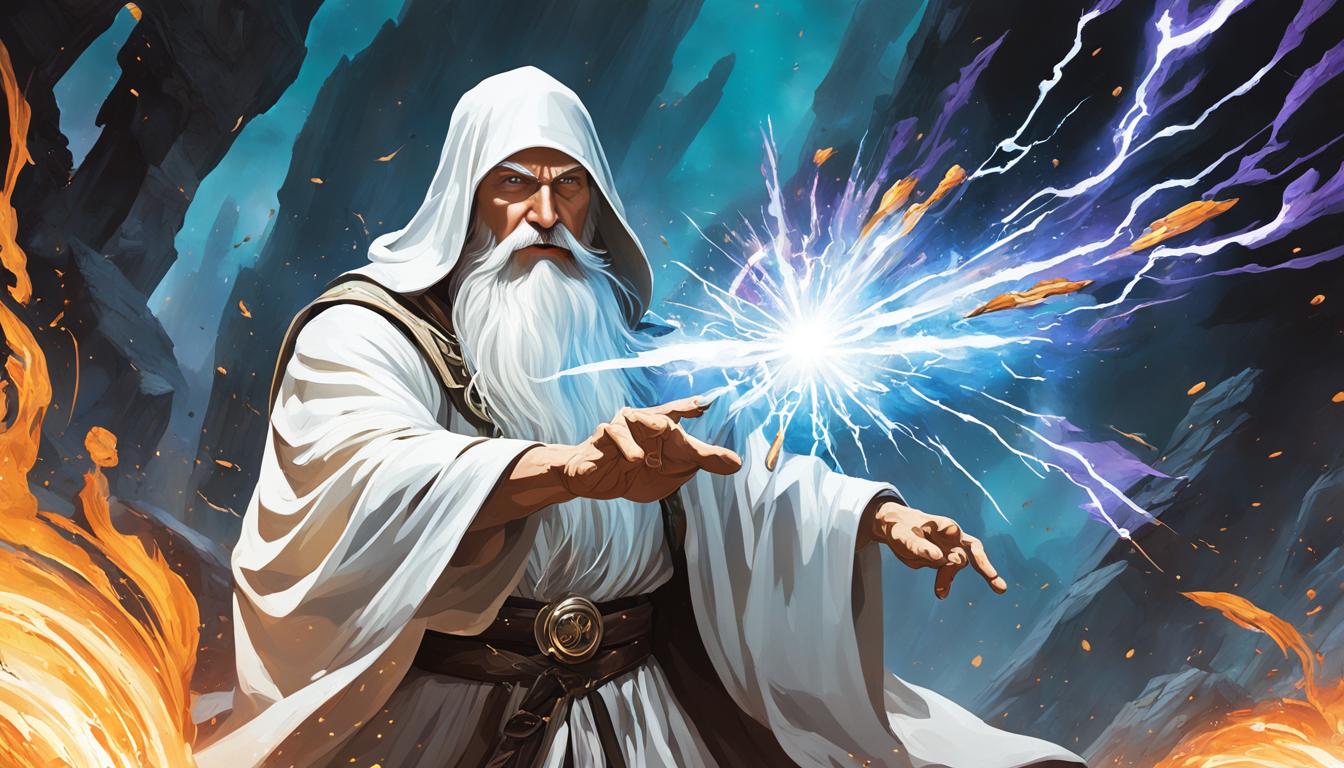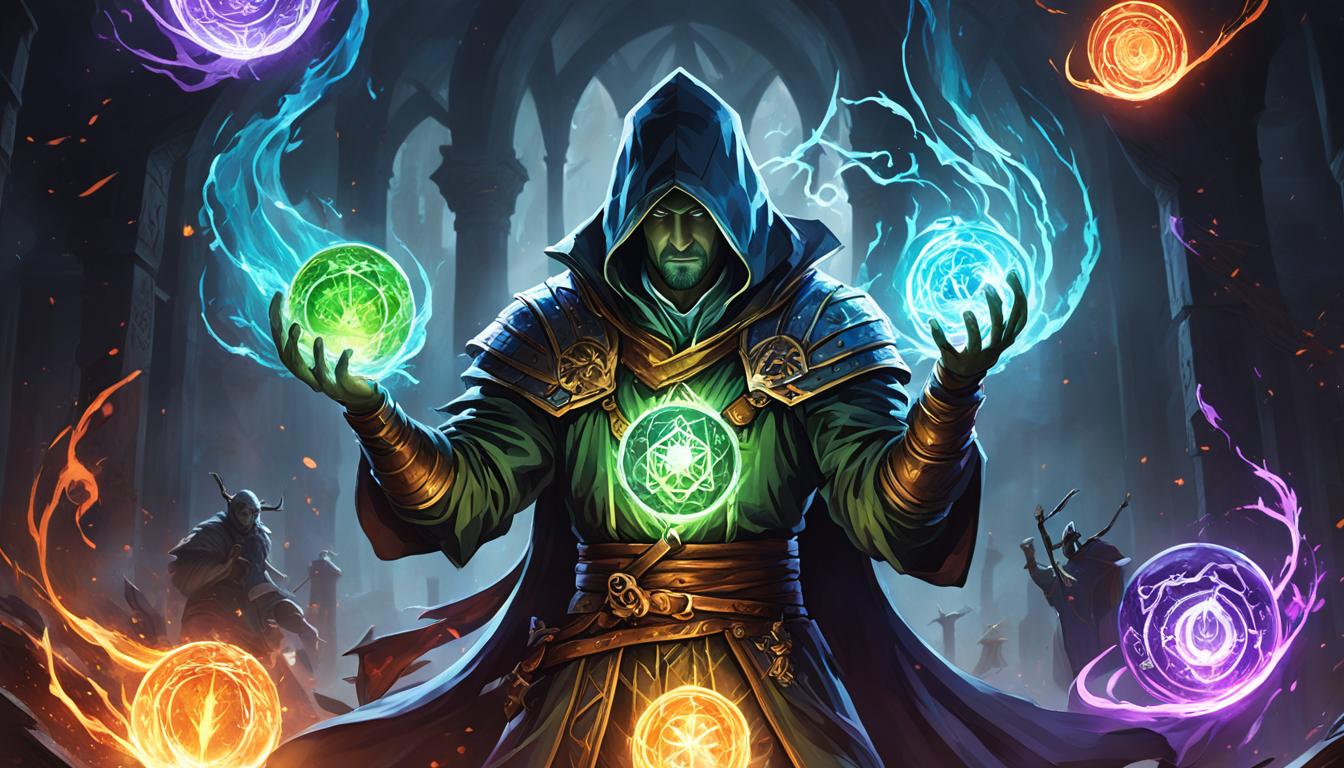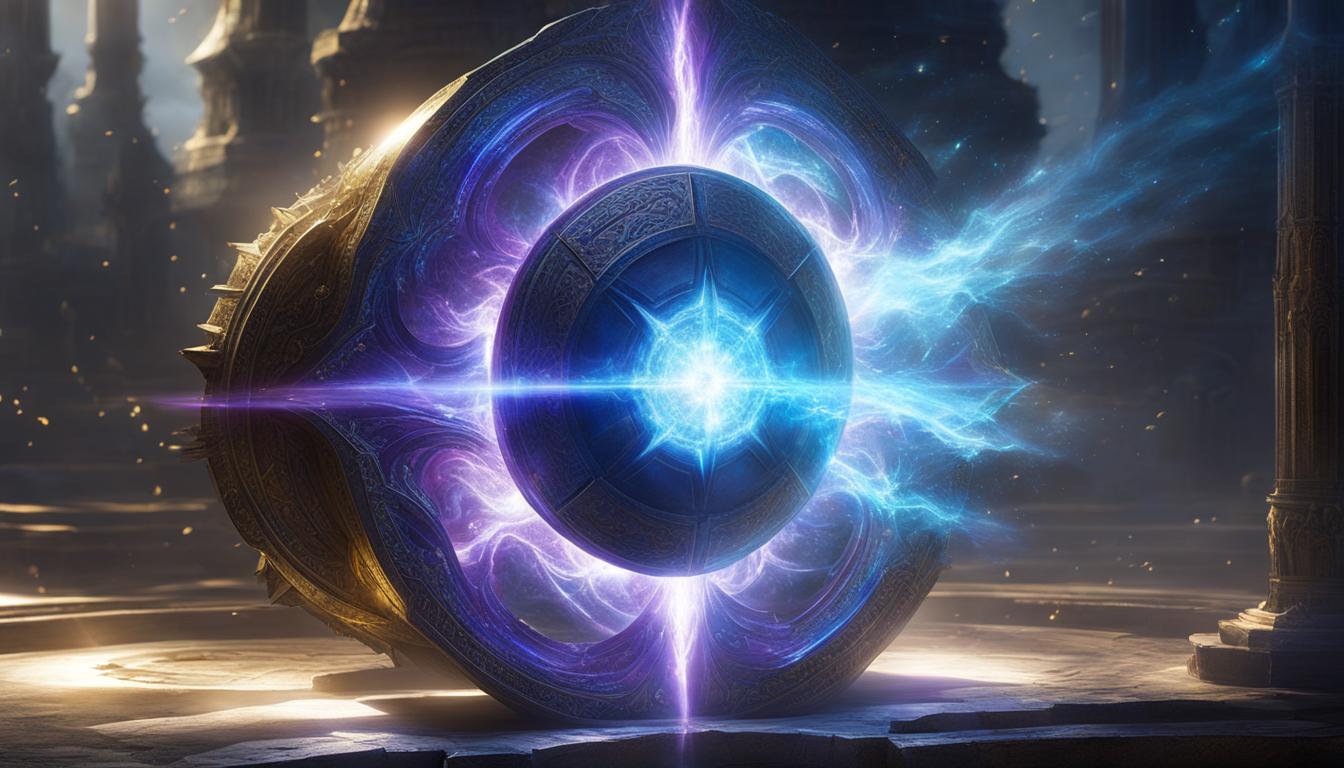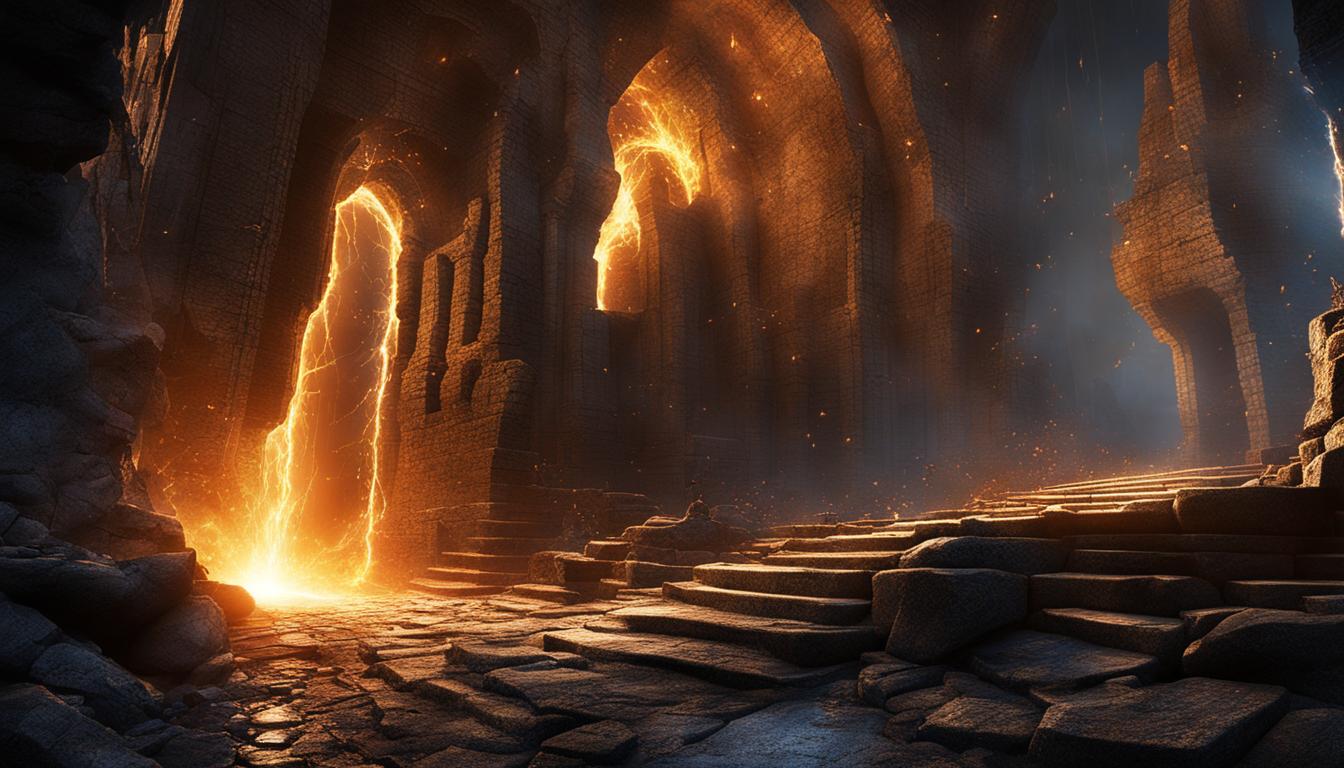Understanding Force Damage 5e – D&D Mechanics
Hey there, fellow adventurers! Today, I want to delve into the fascinating world of D&D mechanics and shed some light on a truly unique damage type, force damage. In Dungeons and Dragons 5e, force damage is a powerful form of magical energy that can wreak havoc on your foes. Now, let’s explore the intricacies of force damage and how it can enhance your gaming experience.
Unlike other damage types in D&D 5e, force damage is not tied to any specific element or theme. It is a pure form of magical energy that can be channeled into a harmful force. This versatility makes force damage stand out from its counterparts, allowing for imaginative and diverse descriptions of its effects.
So, what exactly is force damage and how does it work? Let’s find out!

Key Takeaways:
- Force damage is a pure form of magical energy in D&D 5e.
- It is not associated with any specific element or theme, making it versatile and adaptable.
- Force damage is primarily used by spells.
- It offers players and DMs the opportunity to create unique and imaginative descriptions of its effects.
- Force damage is highly effective, with very few creatures having resistance or immunity to it.
What Is Force Damage in 5e?
Force damage in D&D 5e is a unique and powerful form of magical damage that represents raw magical power. Unlike other damage types, such as fire or lightning, force damage is not associated with any specific element or theme. Instead, it embodies pure magical energy that can be channeled into a destructive force.
Force damage is primarily utilized through spells, making it a favorite among spellcasters who seek to unleash barrages of magical power. Spells like Eldritch Blast and Magic Missile are some of the most well-known examples of force damage spells in the game.
When dealing with force damage, understanding the rules and mechanics becomes crucial. Let’s explore how to deal force damage in 5th edition and gain a deeper understanding of this fascinating damage type.
How Good Is Force Damage?
When it comes to dealing damage in Dungeons and Dragons 5e, force damage stands out as one of the most powerful damage types. Its effectiveness against a wide range of creatures makes it a reliable and formidable choice in combat situations.
Unlike other damage types, force damage faces minimal resistance and immunity among creatures, making it a force to be reckoned with. Whether it’s an incorporeal undead or a heavily armored foe, force damage often proves to be highly effective, as there are few creatures that possess resistance or immunity to it.
As a result, force damage spells provide players with a reliable source of damage that is almost guaranteed to deal full damage to their targets. This makes force damage a versatile tool in the arsenal of Dungeons and Dragons adventurers, allowing them to overcome various challenges with ease.
Whether you’re a spellcasting wizard, a warlock with eldritch powers, or a bard with a penchant for forceful manipulation, the force damage ability provides you with an edge in combat encounters, allowing you to unleash devastating energy upon your foes.
Which Spells Deal Force Damage in 5e?
In Dungeons and Dragons 5e, there are several powerful spells that deal force damage. These spells offer a variety of ways to harness the raw magical energy and unleash it upon your enemies. Here are some of the best force damage spells:
- Eldritch Blast - This popular warlock spell allows you to fire beams of crackling energy at your foes, dealing force damage with each hit.
- Magic Missile - A classic spell that launches magical darts, automatically hitting their targets and dealing force damage.
- Chaos Bolt - This spell creates a shimmering bolt of energy that strikes a target and then bounces to another enemy, dealing force damage along the way.
- Spiritual Weapon - Calling upon a spectral weapon, this spell allows you to make melee spell attacks that deal force damage.
- Disintegrate - With this spell, you can unleash a powerful ray of energy that disintegrates anything it touches, dealing force damage and obliterating your enemies.
These spells are just a few examples of the many options available for dealing force damage in D&D 5e. Each spell offers unique mechanics and can be used strategically to maximize your damage output in combat.

Now, let’s take a deeper look at the details and effects of these force damage spells:
| Spell | Level | Range | Components | Damage |
|---|---|---|---|---|
| Eldritch Blast | Cantrip | 120 feet | V, S | 1d10 force damage (increases with level) |
| Magic Missile | 1st level | 120 feet | V, S | 1d4+1 force damage per dart (multiple darts) |
| Chaos Bolt | 1st level | 120 feet | V, S | 2d8 + 1d6 force damage (increases with level) |
| Spiritual Weapon | 2nd level | 60 feet | V, S | 1d8 + spellcasting modifier force damage |
| Disintegrate | 6th level | 60 feet | V, S, M (diamond worth at least 1000 gp) | 10d6 + 40 force damage |
These spells provide a range of ways to utilize force damage in D&D 5e, whether you’re a spellcaster focused on dealing damage or a character looking to add a bit of magical firepower to your arsenal.
What Deals Force Damage in 5e?
While force damage is primarily associated with spells, there are also other sources in Dungeons and Dragons 5e that can deal force damage. Creatures, items, and class abilities are among the ways force damage can be inflicted. Here are a few examples:
Creatures with Force Damage
Certain spells cast by creatures can deal force damage. For instance, the Mind Flayer can use its Mind Blast ability to deal force damage to multiple targets.
The Banshee has a Wail ability that deals force damage to creatures within a certain range. Class Abilities
The Horizon Walker ranger subclass has a feature called Planar Warrior which allows them to imbue their weapon strikes with force energy, enabling them to deal extra force damage.
The Eldritch Knight subclass for the fighter class can select the Shadow Blade spell, which creates a blade of solidified shadow that deals force damage.
Magical Items
-
Bead of Force: is a magical item that, when activated, creates a sphere of force that deals damage to creatures caught within its area of effect.
-
Wand of Magic Missiles: is another magical item that casts the Magic Missile spell, which inflicts force damage on its targets.
These examples demonstrate that force damage can be inflicted through various means beyond just spells, offering players and dungeon masters different options to incorporate this versatile damage type into their gameplay.
How to Narrate Force Damage?
When it comes to narrating force damage in D&D 5e, the possibilities are endless. Unlike other damage types that have clear visual or thematic associations, force damage allows for more creative descriptions that bring the magic to life. By tapping into the essence of pure magical energy, you can paint vivid pictures of its effects and leave a lasting impression on your players.

Imagine rippling streams of energy cascading from the spellcaster’s fingertips, striking the target with unseen force. Or perhaps you envision invisible balls of power exploding upon impact, leaving the enemy dazed and disoriented. The beauty of force damage lies in its ability to manifest itself in various ways, allowing you to tailor the description based on the situation and the caster’s intent.
Think of force damage as a canvas where you can unleash your creativity. Consider the character’s class, the spell’s flavor, and the setting to craft a unique and immersive experience. Use evocative language, descriptive imagery, and engaging storytelling to transport your players into a world where magic becomes tangible.
If you’re playing as a player character, collaborate with your Dungeon Master to create the force damage narrative. Discuss your character’s chosen spells, their casting style, and the overall themes of your campaign. By working together, you can craft a compelling story that showcases the raw power and beauty of force damage.
Example Descriptions
-
Searing beams of pure arcane energy shoot forth, leaving trails of iridescent light in their wake as they collide with the enemy, causing waves of unseen force to ripple across their body.
-
A miniature maelstrom of swirling magical particles engulfs the target, tearing at their flesh while leaving no visible wounds. They stumble backward, seemingly struck by an invisible tidal wave.
-
The caster’s hands glow with an otherworldly radiance as ethereal chains materialize and lash out, binding the enemy in an inescapable grip. The chains tighten, applying pressure that seems to crush from within, with no physical means of escape.
The key to narrating force damage in D&D 5e is to tap into the limitless potential of magic. Embrace the freedom to imagine and describe this pure form of energy, and watch as your players become enthralled by the immersive power of force damage.
Pros
- Offers versatility in descriptive narrative
- Allows for creativity and unique manifestations of magical energy
- Immersive storytelling potential
Cons
- Requires a vivid imagination
- Can be more challenging to describe compared to other damage types with clear associations
Understanding Resistance, Immunity, and Vulnerability to Force Damage
In Dungeons and Dragons 5e, it’s important to understand how creatures may react to force damage. Some creatures may have resistance, immunity, or vulnerability to force damage, which can greatly impact the outcome of combat encounters.
Resistance to force damage means that the creature takes only half the damage from force damage sources. This can make them more difficult to defeat and require players to strategize their spellcasting and attacks accordingly.
Immunity to force damage means that the creature is completely unaffected by force damage. This can be challenging for players who heavily rely on force damage spells, as they will need to find alternative methods to damage these creatures effectively.
Vulnerability to force damage means that the creature takes double the damage from force damage sources. This can be a significant advantage for players, allowing them to quickly dispatch creatures that are vulnerable to force damage.
It’s important for players and Dungeon Masters to consider these factors when facing creatures that have resistance, immunity, or vulnerability to force damage. It can greatly impact combat strategies and the overall flow of the game.
Now, let’s take a look at some examples of creatures with resistance, immunity, or vulnerability to force damage:
| Creature | Resistance/Immunity/Vulnerability |
|---|---|
| Air Elemental | Immunity to force damage |
| Ghost | Immunity to force damage |
| Helmed Horror | Immunity to force damage |
| Golem (any type) | Immunity to force damage |
| Shadow Demon | Resistance to force damage |
| Tarrasque | Immunity to force damage |
Note: This is not an exhaustive list and there may be other creatures with unique resistances, immunities, or vulnerabilities to force damage.

Conclusion
In conclusion, force damage in D&D 5e is a formidable and versatile damage type that embodies pure magical energy. By harnessing the power of spells, players and DMs can explore a wide array of options for inflicting force damage upon their foes. This damage type proves highly effective, as it encounters minimal resistance and immunity from creatures in the game.
Players can make use of various force damage spells, optimizing their damage output to vanquish adversaries. The freedom to narrate force damage in unique and immersive ways allows for the creation of captivating and memorable gameplay experiences. Force damage serves as a valuable asset in the arsenal of D&D characters, enabling them to wield creative and powerful strategies.
As we journey through the realms of D&D, it is important to recognize the significance of force damage. Its role as a conduit for pure magical energy adds depth and excitement to combat encounters. Whether players choose to unleash torrents of force through spells like Eldritch Blast or evoke the ethereal power of Magic Missile, force damage offers a dynamic and thrilling dimension to the game.
FAQ
What is force damage in D&D 5e?
Force damage is a type of magical damage that represents raw magical power. It is not connected to any specific element or theme, making it versatile and powerful.
How good is force damage in D&D 5e?
Force damage is considered one of the most powerful damage types in D&D 5e. It is highly effective against creatures, as there are few that have resistance or immunity to it.
Which spells deal force damage in D&D 5e?
Some popular spells that deal force damage include Eldritch Blast, Magic Missile, Chaos Bolt, Spiritual Weapon, and Disintegrate.
What can deal force damage in D&D 5e?
In addition to spells, some creatures, items, and class abilities can also deal force damage. For example, certain spells cast by creatures, class abilities like the Horizon Walker ranger’s Planar Warrior, and magical items like the Bead of Force.
How should I narrate force damage in D&D 5e?
When narrating force damage, you have the freedom to be creative. Describe it as rippling streams of energy, invisible balls of power, or any other unique manifestation of magical force.
What is the difference between resistance, immunity, and vulnerability to force damage in D&D 5e?
Resistance means the creature takes half damage from force damage sources, immunity means the creature is unaffected by force damage, and vulnerability means the creature takes double damage from force damage sources.